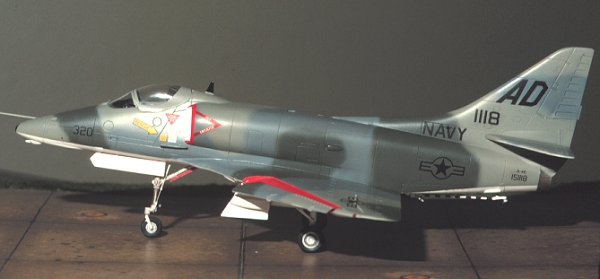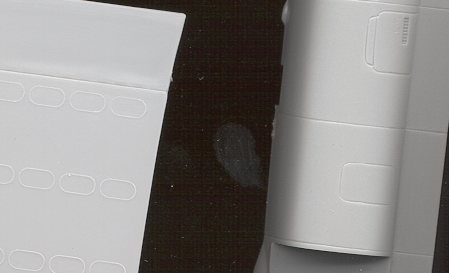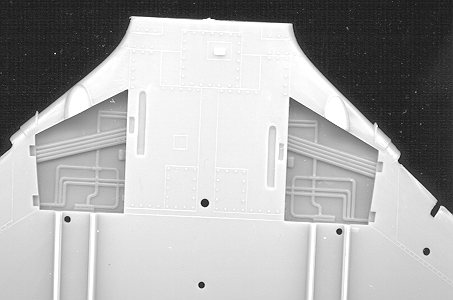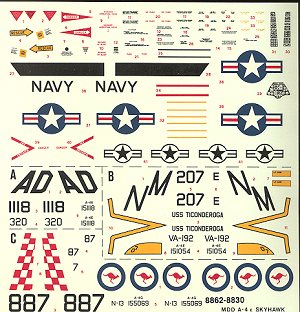
| KIT: | AMT 1/48 A-4E/F Skyhawk |
| KIT # | 8862 |
| PRICE: | @$7.00 in the late 1980s |
| DECALS: | See review |
| REVIEW & | |
| NOTES: | Long out of production / ESCI kit |

| HISTORY |
During the Korean War, the US Navy was looking for a lightattack aircraft. It had to be jet powered, it had to be easy to work on and ithad to carry a decent load. One of the designs turned in was from Douglasdesigner Ed Heinemann (who lived until the mid 1990s). This aircraft was thesmallest airframe that could do the job. There was no wasted space and theaircraft was a very compact design.
So successful was the design that it was kept in production fornearly 20 years and is still in front-line use. The New Zealand Air Forcerecently turned down the F-16 and decided to keep their Skyhawks in service foranother 10 or so years. In addition, Argentina has only recently gotten anadditional shipment of the late model A-4M Skyhawk from those retired from USService. The TA-4J was finally retired from the Navy in 1999!
To say the aircraft was a huge success would almost be anunderstatement. It served well in the front lines in Vietnam until replaced inthe late 1960s by the A-7 Corsair II. Even after that, newer versions weredeveloped for the Marine Corps who used them until retired in the mid 1990s.When pulled out of fleet service, the A-4 was discovered to be the idealagressor aircraft. Very agile and nimble, it's maneuverability made it theperfect Mig-17! This agility was not lost on the Blue Angels, and when it wasdecided to give up the F-4 Phantom for a more 'fuel efficient' aircraft, theSkyhawk was chosen. It went on to serve the team for over 10 years.
In training command, the two-seat TA-4 was found to be theperfect advanced jet trainer, thanks to its ease of handling and maintenance. Itis ironic that the Skyhawk was in fleet service over ten years before its A-7replacement, and lasted nearly ten years after the last A-7 was retired in 1992!There are a few Skyhawks in the hands of warbird enthusiasts.
| THE KIT |

 As many of youalready know, AMT/ERTL purchased ESCI many years back. As a result, a number ofESCI kits have appeared in AMT boxes. One of the better ones was the 1/48Skyhawk. This kit is in the typical ESCI light grey plastic, but withAMT-quality decals (more on that later). This kit is one that was pantographedfrom the smaller 1/72 kit. Frankly, they couldn't have done a nicer job. TheESCI 1/72 A-4 wasn't the most detailed kit ever done, but was much better thanthe off-scale Hasegawa one that was all that small scale modelers had for years.
As many of youalready know, AMT/ERTL purchased ESCI many years back. As a result, a number ofESCI kits have appeared in AMT boxes. One of the better ones was the 1/48Skyhawk. This kit is in the typical ESCI light grey plastic, but withAMT-quality decals (more on that later). This kit is one that was pantographedfrom the smaller 1/72 kit. Frankly, they couldn't have done a nicer job. TheESCI 1/72 A-4 wasn't the most detailed kit ever done, but was much better thanthe off-scale Hasegawa one that was all that small scale modelers had for years.
An interesting anomaly in both the 1/72 and 1/48 kit is that thefuselage is engraved whereas the wings and tailplanes have raised detail! (seethe image to the right). Just why this is has always been a mystery. It isalmost as if different people were designing different parts of the kit! Anyway,the kit is really well done. It has a rather bare but complete interior.Instrument and  console dials andswitches are provided as a decal. The Douglas ejection seat is quite light ondetails but provides a good basis. If desired, the two piece canopy can bedisplayed open but there is no mechanism so one will have to be made.
console dials andswitches are provided as a decal. The Douglas ejection seat is quite light ondetails but provides a good basis. If desired, the two piece canopy can bedisplayed open but there is no mechanism so one will have to be made.
Detail in the wheel wells is not bad (see image to left) and youhave the option of having the slats extended as was the norm when on the ground.There is a multiple ejector rack (MER) for the centerline, 6 bombs, large fueltanks for the inboard wing pylons and rocket pods for the outer pylons. Franklythe MER is best tossed out! Not included in this kit is the avionics hump thatwas on most F models so you really can only do an E from this kit.
Decals are provided for three aircraft. The first on is forVF-192 out of DaNang in 1966. It is in the standard gull grey and white scheme.Also in this scheme are the Skyhawks that were provided to the Australian Navyfor service on the Melbourne with VF-805. It  was one of two Skyhawk squadrons and this one hadred and white checked rudders. Finally an aggressor aircraft from VF-43 at NASOceana in 1976. This one has early low visibility insignia and a three greysupper camouflage scheme with white lower surfaces. Many years ago I built thisparticular version using the ESCI boxing and it turned out quite nice (see imagenear top of review). I am notsure exactly how well the AMT decals will work, but they are the same as whatwas provided in the ESCI boxing only these are quite glossy.
was one of two Skyhawk squadrons and this one hadred and white checked rudders. Finally an aggressor aircraft from VF-43 at NASOceana in 1976. This one has early low visibility insignia and a three greysupper camouflage scheme with white lower surfaces. Many years ago I built thisparticular version using the ESCI boxing and it turned out quite nice (see imagenear top of review). I am notsure exactly how well the AMT decals will work, but they are the same as whatwas provided in the ESCI boxing only these are quite glossy.
The instruction sheet is just about identical to the ESCI sheetgiving 24 construction steps, each one of which has the appropriate colorscalled out. There is also a chart that gives any FS numbers needed for thecamouflage schemes. Though not as detailed as the Monogram kit in this scale, itis a much easier build and when done looks very much like what it is supposed tobe!
While the kit has been long out of production, it can usually befound at swap meets and other places one picks up older kits.
Review copy courtesy of me and my wallet!
If you would like your product reviewed fairly and fairly quickly by asite that has over 900 visits a day, please contactme or see other details in the